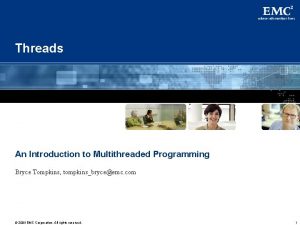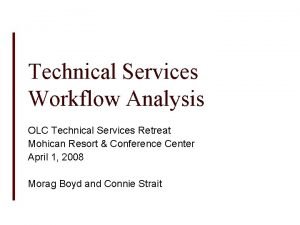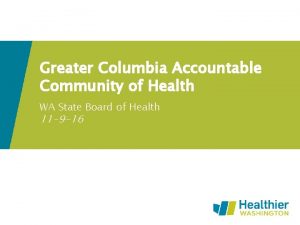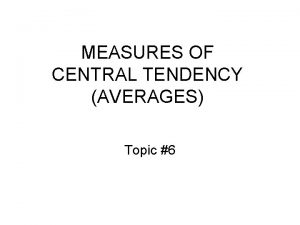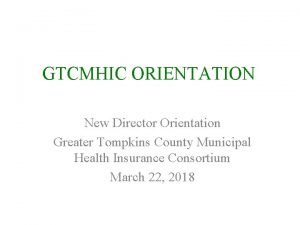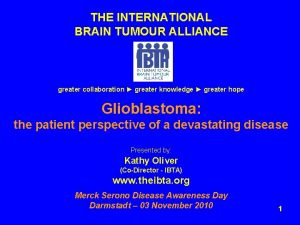GTCMHIC RETREAT Education Retreat of the Greater Tompkins



















































































- Slides: 83

GTCMHIC RETREAT Education Retreat of the: Greater Tompkins County Municipal Health Insurance Consortium Building Medical and Rx Benefit Plans June 12, 2015

PART I Welcome and Introduction Don Barber, Executive Director GTCMHIC

Welcome On behalf of the Greater Tompkins County Municipal Health Insurance Consortium we welcome you to the 2015 Educational Retreat. We thank you for taking the time out of your busy schedules to join us for a day of learning and collaborating with the objective of increasing everyone’s knowledge base to make the Consortium even more successful for many years to come. 3

GTCMHIC Retreat Agenda v v v v v Welcome & Introductions Background & Update Health Insurance Risk Models What are benefit plans? Federal and State Mandates Creating, Changing Benefit Plans Using the benefit plan Provider Networks and Costs Wellness Programs Summation and Questions & Answer Session 4

Introductions v Today’s Presenters v v Don Barber, Executive Director GTCMHIC Steve Locey, Locey & Cahill, LLC Beth Miller, Excellus BCBS Ashley Masucci, Pro. Act v Participants in Attendance v Acknowledgements 5

PART II GTCMHIC Background & Update Don Barber, Executive Director GTCMHIC

Article 47 of the NYS Ins. Law v v Allows Municipalities who Employ <50 Employees to Pool with Municipalities who Employ 50 or more Employees. Regulatory Requirements Include, But are not Limited to: v v Adoption of a Municipal Cooperative Agreement Establishment of Financial Reserves to Cover Liabilities Creating a Role for Labor in the Governance Structure v Joint Committee on Plan Structure and Design v Voting Seats on the GTCMHIC Board of Directors NYS DFS Reporting and Oversight GTCMHIC Certificate of Authority was Issued on 10/01/2010 GTCMHIC Operations Began on 01/01/2011 7

GTCMHIC Update Our List of Municipal Partners v v v v v City of Cortland City of Ithaca County of Tompkins Town of Caroline Town of Danby Town of Dryden Town of Enfield Town of Groton Town of Ithaca v v v v Town of Lansing Town of Ulysses Town of Willett Village of Cayuga Heights Village of Dryden Village of Groton Village of Homer Village of Trumansburg 8

Greater Tompkins County Municipal Health Ins Consortium 2011 -2015 Monthly Covered Lives and Contracts January 1, 2011 to April 30, 2015 8, 000 7, 000 6, 000 5, 000 Number of Covered Lives ≈ 5, 035 Number of Covered Lives ≈ 4, 400 4, 000 3, 000 Number of Contracts (employees/retirees) ≈ 2, 306 Number of Contracts (employees/retirees) ≈ 2, 000 1, 000 0 Jan-11 Jul-11 Jan-12 Jul-12 Jan-13 Number of Covered Lives Jul-13 Jan-14 Number of Contracts Jul-14 Jan-15 Jul-15 9

Medical Plan Premiums 98. 64% Greater Tompkins County Municipal Health Ins. Consortium 2014 Income Distribution January 1, 2014 to December 31, 2014 Ancillary Benefit Plan Premiums 0. 35% Rx Rebates Interest 0. 80% 0. 03% Stop-Loss Claim Reimbursements Other 0. 21% 10 0. 02% Medical Plan Premiums Ancillary Benefit Plan Premiums Interest Rx Rebates Stop-Loss Claim Reimbursements Other

Greater Tompkins County Municipal Health Insurance Consortium Income Distribution (2011 - 2014) 2014 2013 $12, 641 2012 2011 $9, 871 Interest Earnings $7, 332 $6, 004 $134, 659 $146, 563 Other Revenues $105, 902 $167, 294 $36, 063, 291 $34, 507, 670 Medical and Rx Plan Premiums $28, 575, 531 $25, 794, 917 $0 $10, 000 $20, 000 $30, 000 $40, 00011

Paid Claims 92. 08% Greater Tompkins County Municipal Health Ins. Consortium 2014 Expense Distribution January 1, 2014 to December 31, 2014 Admin. Fees 2. 90% Stop-Loss 2. 19% Taxes 0. 80% Ancillary Benefits 0. 39% Professional Services 0. 55% Insurance/Internal Fees 0. 16% 12 Paid Claims Admin. Fees Stop-Loss Taxes and Fees Professional Services Insurance/Internal Fees Ancillary Benefits

Greater Tompkins County Municipal Health Insurance Consortium Expense Distribution (2011 - 2014) 2014 2013 $836, 935 2012 $310, 713 Stop-Loss Ins Net of Recoveries 2011 -$590, 041 -$170, 613 $562, 919 $610, 890 Other Expenses $373, 096 $353, 292 $988, 796 $939, 946 Administrative Fees $928, 502 $841, 543 $29, 755, 490 $28, 013, 757 Claims Expenses $24, 799, 035 $25, 136, 185 -$10, 000 $0 $10, 000 $20, 000 $30, 000 13

Greater Tompkins County Municipal Health Ins Consortium 2011 -2015 Monthly Paid Claims v Budgeted Claims January 1, 2011 to April 30, 2015 $120, 000. 00 $110, 000. 00 $100, 000. 00 $90, 000. 00 $80, 000. 00 $70, 000. 00 $60, 000. 00 $50, 000. 00 $40, 000. 00 $30, 000. 00 $20, 000. 00 $10, 000. 00 $0. 00 Jan-11 Jul-11 Jan-12 Jul-12 Jan-13 Jul-13 Jan-14 Jul-14 Jan-15 Jul-15 14 Budgeted Claims Actual Paid Claims

Greater Tompkins County Municipal Health Ins Consortium 2011 -2015 Annual Paid Claims v Budgeted Claims 7/3/1905 $2, 663, 379. 81 $2, 665, 228. 97 7/4/1905 $6, 594, 871. 36 $8, 339, 928. 42 $7, 388, 617. 00 $7, 294, 687. 16 7/5/1905 $22, 323, 357. 41 $22, 817, 790. 22 $6, 881, 127. 63 $7, 070, 903. 51 7/6/1905 $21, 606, 445. 39 $21, 415, 385. 07 $6, 683, 363. 26 $6, 496, 006. 90 7/7/1905 $18, 085, 105. 63 $19, 674, 216. 88 $6, 504, 972. 43 $5, 828, 602. 12 $15, 685, 691. 75 $15, 947, 080. 94 $0. 00 $5, 000. 00 $10, 000. 00 $15, 000. 00 $20, 000. 00 $25, 000. 00 $30, 000. 00 15 Actual Rx Claims Budgeted Rx Claims Actual Medical Claims Budgeted Medical Claims

Working Collaboratively Medical Provider he P a /PBM TPA You t ical Med tient Benefit Plan 16

PART III Health Insurance Risk Models Stephen Locey, Locey & Cahill, LLC

NYS Health Insurance Risk Models v NYS Fully-Insured Health Insurance Plans: v NYS Insurance Law Article 32 Commercial Insurance Companies Examples: Aetna, CIGNA, Guardian, MVP, United Healthcare v NYS Insurance Law Article 43 Not-for-Profit Insurance Companies Examples: Excellus, Emblem Health (GHI), Health. Now v NYS Public Health Law Article 44 Health Maintenance Organizations Examples: CDPHP, Excellus, Oxford, United Healthcare 18

NYS Health Insurance Risk Models v NYS Self-Insured Plans v Single Employer Self-Insured Plan v Article 47 Municipal Cooperative Health Benefits Plan Greater Tompkins County Municipal Health Insurance Consortium v Article 44 Employee Welfare Funds 19

Risk Models Prior to the Formation of the Consortium All Participating Municipalities were Fully-Insured through an Article 43 insurance company, Excellus BCBS using the following financial models: Experience Rated: City of Cortland City of Ithaca County of Tompkins Town of Ithaca Community Rated: Town of Caroline Village of Cayuga Heights Town of Danby Village of Dryden Town of Dryden Village of Groton Town of Enfield Village of Homer Town of Groton Village of Trumansburg Town of Lansing Town of Ulysses Town of Willett 20

Who Assumes the Risk? Insurance Company Annual Financial Risk Level Self-Insured Plans Community Rated Plans Experience Rated Plans Minimum Premium Retrospective Rating Prospective Rating Low Risk High Risk Employer Annual Financial Risk Level Community Rated Plans Experience Rated Plans Prospective Rating Low Risk Self-Insured Plans Retrospective Rating Minimum Premium High Risk 21

What is Our Risk Model? v Self-Insurance v Article 47 of the N. Y. State Insurance Law v Premiums and Risks are Pooled v Premiums are Established to Cover Statistically Predicted Claims and Fixed Costs (admin. Fees, insurances, etc. ) v Paying for Actual Claims Incurred v Maintaining Reserve Accounts v Excess Funds are Invested and Used for Future Budgets 22

Article 47 of the NYS Ins. Law MUNICIPAL COOPERATIVE HEALTH BENEFIT PLANS Section 4701. Legislative findings. 4702. Definitions. 4703. Application for certificate of authority. 4704. Conditions for issuance of certificate of authority. 4705. Municipal cooperation agreements. 4706. Reserve and surplus requirements. 4707. Stop-loss requirements. 4708. Contingent liability. 4709. Plan benefits and disclosure. 4710. Additional filing requirements and annual report. 4711. Examinations. 4712. Suspension or revocation of certificate of authority. 4713. Plan dissolution. 4714. Transition. 23

Article 47 Plan Benefits § 4709. Plan benefits and disclosure. (a) The governing board of the municipal cooperative health benefit plan shall deliver or cause to be delivered the plan document to all participating municipal corporations and to unions which are the exclusive collective bargaining representatives of employees covered by the plan and the summary plan description to every employee or retiree of participating municipal corporations covered by the plan. (b) The summary plan description shall be subject to regulation as if it were a health insurance subscriber certificate, provided that the superintendent may modify or suspend any provision of this chapter or regulation promulgated thereunder pertaining to scope or type of coverage, if the superintendent determines: (1) such provision of this chapter or regulation to be inappropriate for municipal cooperative health benefit plans; (2) such modification or suspension not to be prejudicial to the interests of covered employees, retirees or dependents; and (3) such modification or suspension not to be destructive of competition. (c) Conspicuously printed on the first page of the plan document and summary plan description, in at least ten point bold-face type, shall be the following statement: "This municipal cooperative health benefit plan is not a licensed insurer. It operates under a more limited certificate of authority granted by the superintendent of financial services. Municipal corporations participating in the municipal cooperative 24 health benefit plan are subject to contingent assessment liability. "

PART IV What are Benefit Plans? : Steve Locey, Locey & Cahill, LLC

What are Benefit Plans? Benefit Plans are a contract between a person and/or their employer and a licensed health insurance company that contains a listing of covered medical care services provided to eligible. As part of a benefit plan health insurance companies typically contract with health care service providers who offer medical care and/or services to you at a reduced agreed upon amount. Benefit Plans must meet minimum Federal and State requirements and include all mandated benefits. 26

What plans are available? v GTCMHIC has a menu of plan options for consideration by labor and management. New plans may be added upon request and approval by the Board of Directors. v Indemnity, PPO, Comprehensive, and Medicare Supplemental plans are available, along with the recently added plan that meets the definition of a “Platinum” metal level plan as offered on the “health insurance exchange. ” v A variety of plan offerings offer labor and management options for negotiation when premiums increase consumes most of compensation increase. 27

Alphabet Soup of Health Insurance v Indemnity or Traditional Plans v Preferred Provider Organization (PPO) Plans v Point of Service (POS) Plans v Health Maintenance Organization (HMO) Plans v High Deductible Health Plans (HDHP) v Health Savings Accounts (HSA) v Flexible Spending Accounts (FSA) 28

Member’s Share of the Costs v Premium Contributions v Annual Deductibles v Coinsurance Amounts (e. g. , 20%) v Copayment Amounts (e. g. , $15. 00) v Out-of-Network Provider Balance Bills v Non-Covered Products or Services 29

PPO Plans vs Indemnity Plans Plan Benefit and Cost Sharing Highlights Sample PPO Plan In-Network (Medical Plan Coinsurance and Medical Plan Copayments, Deductible is not included in this amount) In-Network Out-of-Network Individual Not Applicable $1, 000 $100 Out-of-Network Combined In and Out-of-Network (Medical Only) Family Not Applicable $3, 000 $200 Out-of-Network Combined In and Out-of-Network (Medical Only) Individual $1, 000 $1, 000 $400 In-Network Out-of-Network Combined In and Out-of Network (Medical Only) Family $3, 000 $3, 000 $800 In-Network Out-of-Network Combined In and Out-of Network (Medical Only) Individual $1, 000 Not Applicable Rx Copays Only Family $3, 000 Not Applicable Rx Copays Only Deductible Out-of-Pocket Maximum Out-of-Network Sample Indemnity Plan Out-of-Pocket Maximum (Rx Plan Copayments) Primary Care Physician $10. 00 20% After Deductible Specialist Physician $10. 00 20% After Deductible Inpatient Hospital Covered In Full 20% After Deductible Covered In Full 0% of Allowed Amount Annual Maximum Unlimited Lifetime Maximum Unlimited 30

Rx Plans 2 -Tier vs 3 -Tier vs 4 -Tier v 2 -Tier Rx Plans have different copayments for generic medications and brand name medications. v 3 -Tier Rx Plans utilize a formulary to segregate medications into three tiers. Tier 1 is typically generic medications, Tier 2 is for preferred brand name medications and Tier 3 is for non-preferred brand name medications. v 4 -Tier Rx Plans are very similar to 3 -Tier Rx Plans with the exception that these Plans create an additional Tier 4 for Specialty Medications with an even greater copay. 31

Sample 2 -Tier / 3 -Tier Rx Plans Prescription Drug Plan Rates (Two-Tier Co-Payment Structure Retail Pharmacy Mail-Order Pharmacy Plan Code Generic Brand Name 2 T 1 $1. 00 $0. 00 2 T 2 $2. 00 $5. 00 $0. 00 2 T 3 $2. 00 $10. 00 $0. 00 Prescription Drug Plan Rates (Three-Tier Co-Payment Structure Retail Pharmacy Plan Code Mail-Order Pharmacy Tier 1 Tier 2 Tier 3 Generic Preferred Brand Non-Preferred Brand 3 T 3 $5. 00 $10. 00 $20. 00 $50. 00 3 T 6 $5. 00 $15. 00 $30. 00 $10. 00 $30. 00 $60. 00 3 T 7 $5. 00 $20. 00 $35. 00 $10. 00 $40. 00 $70. 00 3 T 9 $10. 00 $25. 00 $40. 00 $20. 00 $50. 00 $80. 00 3 T 10 $15. 00 $30. 00 $45. 00 $30. 00 $60. 00 $90. 00 3 T 11 20% 40% 15% 40% 3 T 13 20% 30% 50% It should be noted that 3 -Tier models typically include managed care elements such as Step-Therapy, Prior Authorization, Generic Fill Requirements, etc. 32

Actuarial Value (AV) The term “Actuarial Value” references the share of hospital, medical, surgical, and pharmacy care expenses the plan covers for a typical or average group of enrollees within a standard deviation of + or - 2%. A Plan can determine its AV by using: 1. The AV Calculator developed by the Centers for Medicare & Medicaid Services (CMS) Center for Consumer Information & Insurance Oversight (CCIIO) which was implemented in accordance with the Patient Protection and Affordable Care Act of 2010; or 2. The services of an Independent Actuary who will evaluate the Plan’s benefits to determine the likely amount of out-of-pocket 33 costs for the average person covered by the Plan.

Actuarial Value Calculator The term “Actuarial Value” references the share of health care expenses the plan covers for a typical or average group of enrollees within a standard deviation of + or - 2%. As an example, if enrolled in a Platinum Plan the average person would expect the plan to cover approximately 90% of their health care costs in a given year. 34

Why Have Health Insurance Costs Increased Faster than CPI Health Insurance cost increases are a function of many factors including, but not limited to: v Medical Care Inflation v Advancements in Medical Technology v Advancements in Pharmaceuticals v Federal and State Mandated Benefits v Decrease in the “Value” of Cost Sharing Items v Federal and State Taxes and Fees v Medical Malpractice Costs (Insurance & Litigation) 35

Benefit Plans Haven’t Kept Pace v Health Insurance Evolves Over Time v 3 to 5 Years Between Contracts v Health Insurance Trends Outpace Cost-Sharing Changes v Lack of Focus on True Cost Distribution v Plans are Negotiated Line Item by Line Item v Modest Premium Changes = “Major” Benefit Changes 36

Cooperative Health Insurance Fund of CNY BOCES Benefits vs. Medicare Benefits 1990/1991 to 2013/2014 $1, 200 $1, 100 $1, 000 $900 $800 $700 $600 $500 $400 $300 $200 $100 $0 1990/1991 1992/1993 1994/1995 1996/1997 1998/1999 2000/2001 2002/2003 2004/2005 2006/2007 2008/2009 2010/2011 2012/2013 37 OCM BOCES Ded OCM BOCES OOP Max Mx Part B Premium Mx Part B Ded Mx Part A Ded

“ACA Metal Level Plans” Levels of Coverage: The Affordable Care Act contains language which defines the Actuarial Value (AV) of a health insurance plan’s coverage based on the percent of health care expenses covered by the plan for a typical population. Health insurance plans will be placed into four categories based on their Actuarial Value (AV): v Platinum Plan Models Actuarial Value (AV) = 90% v Gold Plan Models Actuarial Value (AV) = 80% v Silver Plan Models Actuarial Value (AV) = 70% v Bronze Plan Models Actuarial Value (AV) = 60% It should be noted that the most common plan models found in the Health Insurance Exchanges are PPO Style Plans and High Deductible Health Plans. 38

ACA 2015 Mandated Limits v Maximum Annual Deductible = $6, 600 Ind. / $13, 200 Fam. v Maximum Annual Out-of-Pocket = $6, 600 Ind. / $13, 200 Fam. v No Annual Limit on Essential Health Benefits v No Lifetime Limit on Essential Health Benefits The above maximums and limits must include all out-of-pocket expenses such as deductibles, coinsurance amounts, and copayments for the hospital, medical, surgical, and pharmacy benefits. This maximums and limits do not include any costs related to out-ofnetwork provider billings and/or the cost for any non-covered services or products. 39

40

41

Maintaining a Plan’s AV v The GTCMHIC established the following process to ensure the Standard Metal Level Plans maintain an Actuarial Value (AV) as defined by the Patient Protection and Affordable Care Act (ACA) equal to an overall plan benefit for the average participant of 90% for the Platinum Plan, 80% for the Gold Plan, 70% for the Silver Plan, and 60% for the Bronze Plan: 1. Changes to the benefits provided by the Metal Level Plans will occur no more frequently than once a year with said benefit changes being effective on January 1 st of the year following the adoption of the said benefit change. 2. Changes to the benefits provided by the Metal Level Plans will be approved by the GTCMHIC’s Board of Directors on or before November 1 st of each year provided the benefit changes maintain the Actuarial Value of the plan in question as defined in Resolution No. 001 -2014. 42

Maintaining a Plan’s AV (continued) 3. Changes to the benefits provided by the Metal Level Plans will be communicated to the affected members no later than December 1 st of each year. 4. The GTCMHIC will adhere to the following definition of the Actuarial Value of each plan. The Greater Tompkins County Municipal Health Insurance Consortium Standard ACA Metal Level Plans will have an Actuarial Value (AV) as defined by the Patient Protection and Affordable Care Act (ACA) equal to an overall plan benefit for the average participant of 90% for the Platinum Plan, 80% for the Gold Plan, 70% for the Silver Plan, and 60% for the Bronze Plan. 43

Maintaining a Plan’s AV (continued) Said AV will be calculated annually using the AV Calculator developed by the Centers for Medicare & Medicaid Services (CMS) Center for Consumer Information & Insurance Oversight (CCIIO) which was implemented in accordance with the Patient Protection and Affordable Care Act. If such calculator is no longer available or in use, the GTCMHIC will have an independent Actuary develop the AV of the health insurance plan on an annual basis. In either case, it is the intent that the result will represent an empirical estimate of the AV calculated in a manner that provides a close approximation to the actual average spending by a wide range of consumers in a standard population and that said AV will be equal to 90% for the Platinum Plan, 80% for the Gold Plan, 70% for the Silver Plan, and 60% for the Bronze Plan within an acceptable deviation of + or – 2% 44

PART V Federal and State Mandates: Stephen Locey, Locey & Cahill, LLC

NYS Minimum Benefits In New York State, the New York State Department of Financial Services regulates health insurance plans to ensure the benefits provided are consistent with the Codes, Rules and Regulation of the State of New York (CCR-NY) for insurance products. In the following, we have provided the actual language as it currently appears in the CCR-NY which forms the basic requirements for all health insurance plans in New York State. Many of these provisions have been augmented through mandated benefit changes either on a Federal or State Level. However, this language should provide an understanding of how health insurance has improved over the years, many times without the need for collectively bargaining the changes. 1. 2. 3. Basic Hospital Insurance (11 CRR-NY 52. 5) Basic Medical Insurance (11 CRR-NY 52. 6) Major Medical Insurance (11 CRR-NY 52. 7) 46

ACA Minimum Essential Benefits ACA required the Secretary of the United States Department of Health & Human Services to specify the “essential health benefits” (EHB) to be included in the “essential health benefits package. ” Starting in 2014, the EHB are required to be included in all Qualified Health Plans (QHPs). EHB is defined in Section 1302(b) of the Patient Protection and Affordable Care Act and includes at least the following general categories of benefit: § § § Ambulatory patient services Emergency services Hospitalization Maternity and newborn care Mental health and substance use disorder services, including behavioral health treatment § Prescription drugs § Rehabilitative and habilitative services and devices § Laboratory services § Preventive and wellness and chronic disease management § Pediatric services, including oral and vision care. 47

State and Federal Mandates v 1993 to 2003 v v 30 New Benefit Mandates 2003 to 2013 v v 51 New Benefit Mandates 2010 PPACA Added Legislative changes to health insurance are mandated changes which occur without Consortium approval. In addition, these changes are made outside of the collective bargaining environment without labor or management consideration or 48 approval.

Government Mandate Highlights v v v v v Well Child Visits Routine Cervical Cancer Screenings Mental Health Parity Act Diabetic Treatment Chiropractic Care Coverage Adopted Newborn Coverage from Birth Breast Reconstruction Oral Contraceptives Prostrate Cancer Screenings Exclusions Annual Routine Physical and Adult Immunizations v Bone Density Treatment v Chemical Dependency for inpatient and outpatient v Contraceptives Drugs & Devices v NYS Dependent to age 29 v HCR Dependents to 26 v NYS Same Sex Marriage v Timothy’s Law (Mental Health Parity) v Removal of Annual Maximums v 49

What Can Be Excluded? v v v v Aviation Convalescent and Custodial Care Cosmetic Services Coverage Outside of the US, Canada, or Mexico Dental Services Experimental or Investigational Treatment Felony Participation Foot Care v v v v Government Facility v Not Medically Necessary v Military Service v No-Fault Automobile v Insurance Services Not Listed Services Provided by a Family Member Services Separately Billed by a Hospital Employees Services with No Charge Vision Services War Worker’s Compensation 50

Cost of Care Provider Access 51

PART VI Creating and Changing Benefit Plans: Steve Locey, Locey & Cahill, LLC

Consortium Specific Benefit Plans v Idea for New Plans or Potential Modifications to “Old” Plans comes from Within the Consortium or from Outside Potential New Partners v Plan Consultant Researches and Presents Draft Plan v After Consideration by Consortium Committee Structure, the Board of Directors Considers Plan for Adoption v Adopted Plans must be Approved by NYS DFS Before Issuance in Accordance with § 4709(b) 53

NYS Insurance Law § 4709(b) § 4709. Plan benefits and disclosure. (a) The governing board of the municipal cooperative health benefit plan shall deliver or cause to be delivered the plan document to all participating municipal corporations and to unions which are the exclusive collective bargaining representatives of employees covered by the plan and the summary plan description to every employee or retiree of participating municipal corporations covered by the plan. (b) The summary plan description shall be subject to regulation as if it were a health insurance subscriber certificate, provided that the superintendent may modify or suspend any provision of this chapter or regulation promulgated thereunder pertaining to scope or type of coverage, if the superintendent determines: (1) such provision of this chapter or regulation to be inappropriate for municipal cooperative health benefit plans; (2) such modification or suspension not to be prejudicial to the interests of covered employees, retirees or dependents; and (3) such modification or suspension not to be destructive of competition. (c) Conspicuously printed on the first page of the plan document and summary plan description, in at least ten point bold-face type, shall be the following statement: "This municipal cooperative health benefit plan is not a licensed insurer. It operates under a more limited certificate of authority granted by the superintendent of financial services. Municipal corporations participating in the municipal cooperative health benefit plan are subject to contingent assessment liability. " 54

Building a Health Insurance Plan Basic and Required “Building Blocks” of a Benefit Plan v Determine the “Style” of the Plan or Type of Plan (indemnity, PPO, POS, HMO, HDHP, etc. ) v Membership (Who is Covered? ) v NYS Minimum and Mandated Benefits v PPACA Essential Health Benefits v List of Exclusions 55

Who is Required to be Covered? v Contract Holder v v v Active Employees Qualified Retirees Dependent Children v v v Covered to Age 26 Handicapped Dependents Young Adult Option v Qualified Medical Child Support Orders v COBRA Continuation of Benefits 56

Who May Also be Covered? v Legal Spouses v v Same Sex Marriages Where Legally Recognized Includes Separated, but Not Divorced Spouses v Domestic Partners v Dependent Children to Age 30 v New York State “Make Available Option” 57

Building a Health Insurance Plan Key Decision Elements in Overall Plan Design v Member Cost Sharing Items and Levels Deductibles, Coinsurance Amounts, Copayments, Limits v Out-of-Network Reimbursement Methodology v Day Limitations on Certain Benefits (e. g. , Physical Therapy, Speech Therapy, Physical Rehab) v Inclusion of Optional Benefits (e. g. , Acupuncture, Vision, Hearing, Dental, and Wellness) 58

How are Changes Made to “Old Style” Health Insurance Plans? v Plans may only change upon successful collective bargaining or legislative action as permitted. v The GTCMHIC cannot unilaterally change benefit plans. v Each municipality has their own group number and selected plan offerings per their agreements and policies. v To add a new plan you must contact Beth Miller at Excellus BCBS who will coordinate with Ashley Masucci at Pro. Act, Inc. v Please allow 60 - 90 days to implement a new group 59

How are Changes Made to “GTCMHIC Metal Level” Plans? v AV is Calculated on an Ongoing and Periodic Basis v If AV is not within Standard Deviation Range, Suggested Changes will be Reviewed with the Joint Committee v The Joint Committee will Recommend Changes to the Board v The Board of Directors will Approve the Plan Changes v Notifications are Made to Covered Members v Changes are Coordinated with Excellus and Pro. Act v Plan Changes Effective January 1 st Following Approval 60

PART VII Using a Benefit Plan: Beth Miller, Excellus Blue. Cross Blue. Shield Ashley Masucci, Pro. Act

Common Types of Services v v v v v Primary Care Services and Immunizations Diagnostic Laboratory and Radiology Convenient Care / After Hours Care Urgent Care / Emergency Care Specialist Care (orthopedics, oncology, cardiology, etc. Surgical Services (Surgeon and Assistant Surgeon) Anesthesiology Services Therapy Services (Physical, Speech, Occupational, etc. ) Rehabilitation Services (Physical, Mental Health, etc. ) Pharmaceutical Services and Medications 62

Common Questions to ask the Doctor: 1. 2. 3. 4. 5. Medical Care is Sought Billed to Insurer Determines Pay Co-Pay Cost of Care Person Needs Medical Care What are my treatment options? What services will be performed? What services do I really need? How much will the services cost? Will a generic drug work for me? to Doctor if service is covered unted Disco ctor to Do rat e paid Bill to Patien t Common Patient Costs: 1. 2. 3. 4. Deductible Coinsurance Amounts (e. g. , 20%) Non-Covered Items/Services Non-Par Provider Balances 63

Claim received by Insurer/Admin. 1. 2. 3. 4. 5. 6. Claims Adjudication Process: Is the Patient covered by the Plan? What type of plan design is in place? Is the service a covered item? Is the service medically necessary? Is the Provider participating? Does the Patient have cost sharing? a. Deductible b. Coinsurance c. Copayment Discounted rate paid to Medical Provider 64

PART VIII Provider Networks and Costs: Beth Miller, Excellus Blue. Cross Blue. Shield Ashley Masucci, Pro. Act, Inc.

Arenas of Care v Hospital v v v Inpatient Outpatient Medical/Surgical Care “Major Medical” Prescription Drugs 66

Common Places of Treatment v v v v Hospital v Inpatient Services v Outpatient Services v Emergency Care Services Skilled Nursing Facilities Ambulatory Surgical Care Centers Urgent Care Facilities Residential Psychiatric / Substance Abuse Facilities Physician Offices / Clinics Patient’s Residence (Home Care or Visits) Pharmacies (Retail, Mail-Order, and Specialty) 67

Provider Networks v Healthcare Services Covered by a Benefit Plan Need Pre. Determined, Discounted Pricing from Medical Providers, Facilities, and Pharmacies to Reasonably Predict Claims Costs and Resulting Premiums. v Health Insurance Administrators and Prescription Benefit Managers Need a Provider Network in Order to Keep Prices Down and Provide Covered Members with Access to the Care They Need. v The GTCMHIC Contracts with Excellus BCBS for Hospital, Medical, and Surgical Claims Administration and with Pro. Act for Prescription Drug Claims Administration. 68

Working Collaboratively Medical Provider he P a /PBM TPA You t ical Med tient Benefit Plan 69

In-Network vs Out-of-Network v In-Network Care v v Is care provided to a patient by a medical care provider, facility, or pharmacy who has a contract in place with an insurance company, third party administrator, or pharmacy benefit manager to deliver medical services, care, and/or materials at a pre -determined cost or pre-determined rate of reimbursement. The patient is only responsible for their deductible, coinsurance amounts, and/or copayments not to exceed their out-of-pocket maximum for the year. Out-of-Network Care v Is care provided to a patient by a medical care provider, facility, or pharmacy who does not have a contract in place with an insurance company, third party administrator, or pharmacy benefit. The patient is not only responsible for their deductible, coinsurance amounts, and/or copayments not to exceed their out-ofpocket maximum for the year, but is also responsible for any balances above the amount allowed by the insurance company, third party administrator, or pharmacy benefit. 70

Medical Plan Administrator v The Medical Plan Administrator, sometime referred to as a Third Party Administrator, for the GTCMHIC is Excellus Blue. Cross Blue. Shield. The services they provide to the covered members include, but are not limited to, the following: v v v v Membership and Billing ID Card Issuance Customer Service Claims Adjudication Negotiated Discounts Medical Provider Network Development and Management Medical Case Management Fraud and Abuse Detection 71

Excellus BCBS Service Area 28, 301 Providers 80 Hospitals 72

Out-of-Area Medical Care v Excellus BCBS – Blue Card Program 73

Provider Network Savings 74

Prescription Benefit Manager v The Prescription Benefit Manager (PBM) for the GTCMHIC is Pro. Act, Inc. , a subsidiary of Kinney Drugs, Inc. The services they provide to the covered members include, but are not limited to, the following: v v v v v Membership and Billing ID Card Issuance Customer Service Claims Adjudication Negotiated Pharmacy Discounts Pharmacy Network Development and Management Medical Case Management Mail-Order Pharmacy Services Specialty Pharmacy Services 75

Pro. Act National Pharmacy Network Pro. Act’s National Network includes over 67, 000 chain and independent pharmacy locations across the United States, Puerto Rico, the United States Virgin Islands, and Guam, with no major retail or key independent pharmacies excluded. Based on the National Council for Prescription Drug Programs files, over 90% of the pharmacies in the United States have enrolled in this network. Our retail pharmacy network provides member convenience no matter where they need to fill their prescription. 76

Balancing Cost and Access of Care Cost of Care Provider Access Excellus and Pro. Act are charged with keeping costs down while still providing access to the medical providers, facilities, and pharmacies patients need for their care. This is a delicate balance to achieve while also requiring participating providers to adhere to certain quality and accountability standards. 77

PART IX Wellness Programs: Don Barber, GTCMHIC Executive Director

Wellness Vision A community that values and practices preventative health care to promote health and prevent disease. 79

Wellness Programs Work for Individuals and the Collective v Healthy patients are happy, able to do more recreational activities for longer periods, and recover from injury and illness faster v Many diseases are preventable with early diagnosis like glucose, blood pressure, cholesterol, and body mass index. v Becoming aware of your numbers and making life style choices to lower your risk will keep out of the hospital and with your family , lower your costs of care and lower the Consortium’s share of your cost of care. 80

Wellness & GTCMHIC Metal Plans Wellness is a benefit component of all the GTCMHIC Standard Metal Level Plans (Platinum, Gold, Silver, and Bronze). The GTCMHIC OYOH Committee Welcomes Your Ideas and Thoughts. 81

PART IX Summation and Q&A Period: Don Barber, GTCMHIC Executive Director

83
 Tompkins county solid waste
Tompkins county solid waste Stephanie tompkins
Stephanie tompkins Sally tompkins
Sally tompkins Gnutop
Gnutop White wolf retreat big sky
White wolf retreat big sky Olc technical services retreat
Olc technical services retreat Vipassana 10 day silent retreat substance abuse
Vipassana 10 day silent retreat substance abuse Covetousness
Covetousness Retreat at rtp
Retreat at rtp Physician burnout retreat
Physician burnout retreat Atmana vindyate viryam
Atmana vindyate viryam Retreat evaluation form
Retreat evaluation form Deletion indicators cryptic
Deletion indicators cryptic Apa pengertian dribling menurut vic ambler(2005: 10) .. *
Apa pengertian dribling menurut vic ambler(2005: 10) .. * Free face slope
Free face slope Cái miệng nó xinh thế chỉ nói điều hay thôi
Cái miệng nó xinh thế chỉ nói điều hay thôi Các châu lục và đại dương trên thế giới
Các châu lục và đại dương trên thế giới Bổ thể
Bổ thể Từ ngữ thể hiện lòng nhân hậu
Từ ngữ thể hiện lòng nhân hậu Tư thế ngồi viết
Tư thế ngồi viết V cc
V cc Thể thơ truyền thống
Thể thơ truyền thống Làm thế nào để 102-1=99
Làm thế nào để 102-1=99 Chúa yêu trần thế alleluia
Chúa yêu trần thế alleluia Hổ sinh sản vào mùa nào
Hổ sinh sản vào mùa nào đại từ thay thế
đại từ thay thế Diễn thế sinh thái là
Diễn thế sinh thái là Vẽ hình chiếu vuông góc của vật thể sau
Vẽ hình chiếu vuông góc của vật thể sau Công của trọng lực
Công của trọng lực Tỉ lệ cơ thể trẻ em
Tỉ lệ cơ thể trẻ em Thế nào là mạng điện lắp đặt kiểu nổi
Thế nào là mạng điện lắp đặt kiểu nổi Lời thề hippocrates
Lời thề hippocrates Vẽ hình chiếu đứng bằng cạnh của vật thể
Vẽ hình chiếu đứng bằng cạnh của vật thể Quá trình desamine hóa có thể tạo ra
Quá trình desamine hóa có thể tạo ra Phản ứng thế ankan
Phản ứng thế ankan Môn thể thao bắt đầu bằng chữ f
Môn thể thao bắt đầu bằng chữ f Sự nuôi và dạy con của hươu
Sự nuôi và dạy con của hươu Hát kết hợp bộ gõ cơ thể
Hát kết hợp bộ gõ cơ thể Dạng đột biến một nhiễm là
Dạng đột biến một nhiễm là điện thế nghỉ
điện thế nghỉ Biện pháp chống mỏi cơ
Biện pháp chống mỏi cơ Trời xanh đây là của chúng ta thể thơ
Trời xanh đây là của chúng ta thể thơ Gấu đi như thế nào
Gấu đi như thế nào Thiếu nhi thế giới liên hoan
Thiếu nhi thế giới liên hoan Tia chieu sa te
Tia chieu sa te Một số thể thơ truyền thống
Một số thể thơ truyền thống Thế nào là hệ số cao nhất
Thế nào là hệ số cao nhất Hệ hô hấp
Hệ hô hấp Ng-html
Ng-html Bảng số nguyên tố lớn hơn 1000
Bảng số nguyên tố lớn hơn 1000 Tư thế ngồi viết
Tư thế ngồi viết đặc điểm cơ thể của người tối cổ
đặc điểm cơ thể của người tối cổ Mật thư anh em như thể tay chân
Mật thư anh em như thể tay chân Các châu lục và đại dương trên thế giới
Các châu lục và đại dương trên thế giới Thang điểm glasgow
Thang điểm glasgow ưu thế lai là gì
ưu thế lai là gì Thẻ vin
Thẻ vin Backbone of extension education
Backbone of extension education Venn diagram formal education and nonformal education
Venn diagram formal education and nonformal education Difference between health education and propaganda
Difference between health education and propaganda Lemonade tycoon online
Lemonade tycoon online Greater oklahoma city population
Greater oklahoma city population There is no greater bore than perfection
There is no greater bore than perfection Inequality key words chart
Inequality key words chart Greater than god more evil than the devil
Greater than god more evil than the devil Greater columbia accountable community of health
Greater columbia accountable community of health Gow gates technique
Gow gates technique What is epiploic foramen
What is epiploic foramen Head hairs and pubic hairs exhibit a greater range of
Head hairs and pubic hairs exhibit a greater range of Strategic planning workshop greater manchester
Strategic planning workshop greater manchester Infratemporal fossa
Infratemporal fossa Migratory aptitude is greater for
Migratory aptitude is greater for Lingual artery
Lingual artery Greater baltimore realtor association
Greater baltimore realtor association Which is greater?
Which is greater? Thigh region
Thigh region Mother any distance poem analysis
Mother any distance poem analysis Compound inequality examples
Compound inequality examples Mean higher than median
Mean higher than median Greater manchester ageing hub
Greater manchester ageing hub A cell is a living unit greater than the sum of its parts
A cell is a living unit greater than the sum of its parts The verbal phrase of the inequality symbol
The verbal phrase of the inequality symbol Asvab average scores
Asvab average scores Saint james the moor slayer
Saint james the moor slayer



